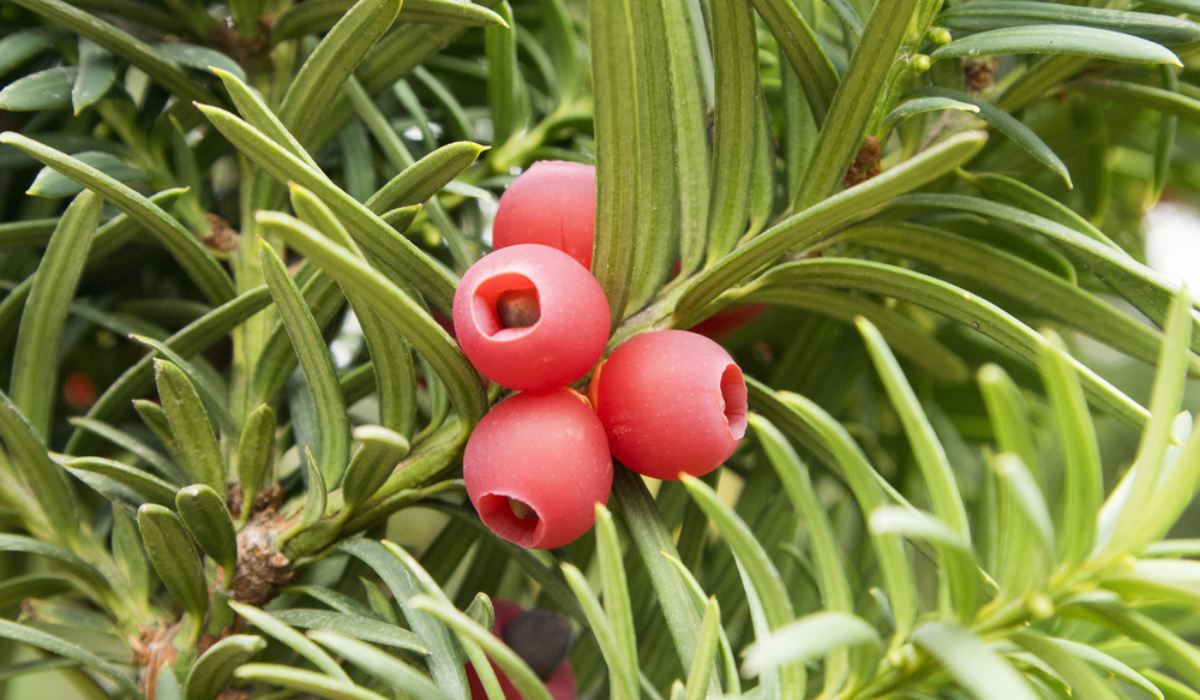The Yew plant is a resilient evergreen shrub known for its dark green foliage and distinctive red berries. It has a striking appeal and hence grown in many gardens. During Christmas, the Yew is cherished and used in decorations as a symbol of longevity and spirituality. It reflects the festive spirit, symbolising life and continuity during the winter holiday.
See also: How to grow and care for a Christmas tree at home?
Yew: Key facts
| Scientific name | Taxus baccata |
| Family | Taxaceae |
| Common name | English yew, European yew |
| Seed type | Enclosed |
| Flower type | Inconspicuous |
| Plant Growth | Woody Shrub -Tree |
| Height | 3-25 feet |
| Life Span | Perennial |
| Foliage | Evergreen |
Physical characteristics of Yew?
The yew, or the English yew, is conical-shaped and is usually in the form of a shrub or a small tree. The shrubs are usually large – an average of three to 25 foot, depending on whether it is a shrub or tree. The branches of a yew tree are spread with dark green leaves. The leaves are needle-shaped and linear. The dark green leaves are older than the fresh light green needle leaves of yew. The branches are dropping and conifers are produced through it. The conifers are used to make new yew trees.
Yew: Longevity
The English yews are popular for their longevity. The yew lives for a very long time. There are more than 2000 to over 5000-year-old yews present in Great Britain. The yew is known to be one of the oldest plants in Europe. These old trees are found in Fortinghall Yew.
History of Yew
The English yew is an evergreen tree or a shrub that is widely present in the Asian region and European regions. The Himalayas are filled with yews that botanists love to explore due to their variation and adaptability to extreme conditions. The yew present in the Himalayas is called Himalayan yew.
Yew and religion
English yew is famous among various religious sects. The yew is known as a symbol for having a long life ahead. The yew has great significance in Christianity and Greek culture. The funeral wreaths are made using the yew to honour the Hecate, also known as the dominion of the death itself. The Celts used yew to plant it in their shrines and believed in the magic of yew. The Celt’s conversion to Christianity did not change the importance of yew.
How to grow yew?
The yew produces a fleshy seed coat for its seed protection. The yew can grow in any amount of sunshine. It is ideal for yew to grow in moist and fertile areas. The soils in such places are sandy and loamy. The best place for yew to grow is in a partially shaded spot or a fully shaded area. It cannot grow well under wet conditions or when the soil is drained.
Yew: Propagation
The yew plant can be produced through the seed or stem through cutting. Hardwood cuttings propagate it. Pruning the yew is also suitable for its health. The English yew can be produced with the seeds using a stratification for about 120 to 365 days.
Yew is available in various sizes, including compact, dwarf, etc. The wilder species are found relatively rarely. Yew is known for its poison and fatality.
Even though yew is toxic, it is used for some medicinal purposes. The formulations are prepared in a controlled environment. The highly poisonous nature makes it unfit for a home remedy. It is best to use yew with a doctor’s consultation. Once a person gets any symptoms, they should rush to the hospital immediately before it worsens.
Pest issues with Yew
The most common pests that affect the yew plant are vine weevils, scale and mealybugs. They can involve the twigs and needles of this plant. They rot the plant and destroy it. Extreme conditions also affect the plant severely; yew can suffer from burns, too, such as winter burns.
Uses of Yew
Yew was a part of traditional medicine in the past. The toxicity it has was ignored or diminished by the use of yew for many illnesses over centuries. The native Americans used yew in treating fever, arthritis and rheumatism. Japan is a common place for using yew in treating diabetes and abortions.
Nowadays, yew helps make Paclitaxel and Docetaxel effective in cancerous cells. Yew is also used to make baskets and fire. Yew has been used in meat and gin preservation during their making. Taxol is a drug used for the treatment of ovarian and breast cancer. It is beneficial in the healthcare industry. The lab creates the drug using yew.
Word of advice
Yew is not a safe option in terms of medicine. It is better to consult a doctor before using yew to prevent an issue. It is better not to let pregnant women and children use yew for any medicinal purpose. It is noted to be hazardous for pregnancy and abortion.
Toxicity in Yew
The English yew is known for its toxicity. Its seeds, leaves and foliage are very poisonous alkaloids. It contains taxol, which is highly toxic if not supervised medically before consumption. Yew is fatal for both humans and animals. It should be kept away before anyone mistakenly ingests it. The chemicals in the plant are poisonous to the cells in the heart. It causes cells to work differently, making the heart beat faster or slower than usual. The yew causes various stomach issues, and the poisoning can cause extreme symptoms such as nausea, vomiting, etc. Many people have recorded nervousness, weakness, dizziness and stomach pain after consuming yew. Death can occur after the consumption of just 50 to 100 grams of needles of yew.
FAQs
What is the scientific name of yew?
Taxus Baccata is the scientific name of yew.
What are the different types of yew?
Yew can be grown as a shrub or a tree.
What is the main chemical present in yew?
Taxol is the chemical present in yew.
What are the different popular names of yew?
English, European and Common yew are the names common for yew.
What is the height of yew?
The yew grows from 3 to 25 foot on average.
What are the medical uses of Yew?
The yew is used for breast and ovarian cancer.
How to produce yew?
Yew is produced through its seed or stem cutting.
| Got any questions or point of view on our article? We would love to hear from you. Write to our Editor-in-Chief Jhumur Ghosh at jhumur.ghosh1@housing.com |






